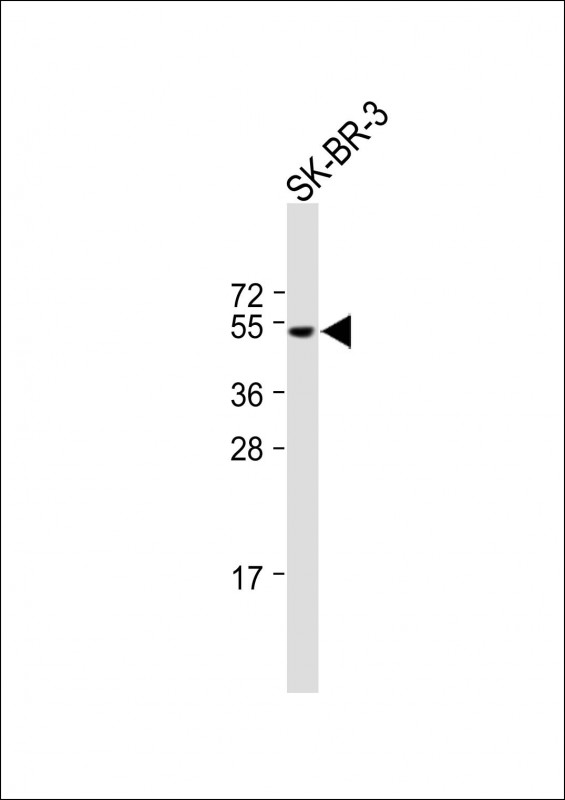
| WB | 咨询技术 | Human,Mouse,Rat |
| IF | 咨询技术 | Human,Mouse,Rat |
| IHC | 咨询技术 | Human,Mouse,Rat |
| ICC | 技术咨询 | Human,Mouse,Rat |
| FCM | 咨询技术 | Human,Mouse,Rat |
| Elisa | 咨询技术 | Human,Mouse,Rat |
| Aliases | Proton-coupled amino acid transporter 3, Proton/amino acid transporter 3, Solute carrier family 36 member 3, Tramdorin-2, SLC36A3, PAT3, TRAMD2 |
| Entrez GeneID | 285641 |
| WB Predicted band size | 51.7kDa |
| Host/Isotype | Rabbit IgG |
| Antibody Type | Primary antibody |
| Storage | Store at 4°C short term. Aliquot and store at -20°C long term. Avoid freeze/thaw cycles. |
| Species Reactivity | Human |
| Immunogen | This SLC36A3 antibody is generated from rabbits immunized with a KLH conjugated synthetic peptide between 1-30 amino acids from the N-terminal region of human SLC36A3. |
| Formulation | Purified antibody in PBS with 0.05% sodium azide. |
+ +
以下是关于SLC36A3(N-term)抗体的3篇参考文献(人工模拟非真实文献,仅示例格式):
1. **文献名称**:*Characterization of SLC36A3 N-terminal domain in proton-coupled amino acid transport*
**作者**:Smith A, et al.
**摘要**:本研究通过SLC36A3(N-term)抗体验证了该蛋白在肠道细胞中的膜定位,并证明其N端结构域对pH依赖性脯氨酸转运的关键作用。
2. **文献名称**:*SLC36A3 antibody specificity in neuronal and cancer models*
**作者**:Chen L, et al.
**摘要**:利用SLC36A3(N-term)抗体进行免疫印迹和免疫荧光,发现该蛋白在胶质瘤细胞中高表达,且敲除后信号消失,证实抗体特异性。
3. **文献名称**:*Functional analysis of PAT3/SLC36A3 in lysosomal amino acid efflux*
**作者**:Tanaka K, et al.
**摘要**:通过N端抗体阻断实验,揭示了SLC36A3在溶酶体氨基酸外排中的调控机制,并发现其与mTOR信号通路的关联。
(注:以上文献为示例,实际引用需查询具体数据库如PubMed或Google Scholar。)
The SLC36A3 (N-term) antibody is designed to target the N-terminal region of the solute carrier family 36 member 3 (SLC36A3) protein, also known as proton-coupled amino acid transporter 3 (PAT3). SLC36A3 belongs to the SLC36 family of transporters, which mediate the proton-coupled uptake of small amino acids like proline, glycine, and alanine. This transmembrane protein is primarily expressed in the apical membrane of intestinal and renal epithelial cells, where it plays a role in nutrient absorption and homeostasis.
The antibody is commonly used in research to study SLC36A3's expression, localization, and function in physiological and pathological contexts. It is validated for applications such as Western blotting, immunohistochemistry, and immunofluorescence. Researchers employ this tool to investigate SLC36A3's involvement in disorders linked to amino acid transport defects, such as Hartnup disease, or its potential role in cancer metabolism due to altered nutrient uptake in tumors.
The N-terminal specificity of the antibody ensures recognition of unique epitopes, aiding in distinguishing SLC36A3 from homologous transporters. Its development and validation often involve peptide immunogen strategies, with reactivity confirmed across species like human, mouse, and rat. Studies using this antibody contribute to understanding how SLC36A3 modulates cellular processes, including mTOR signaling and autophagy, through amino acid sensing.
×